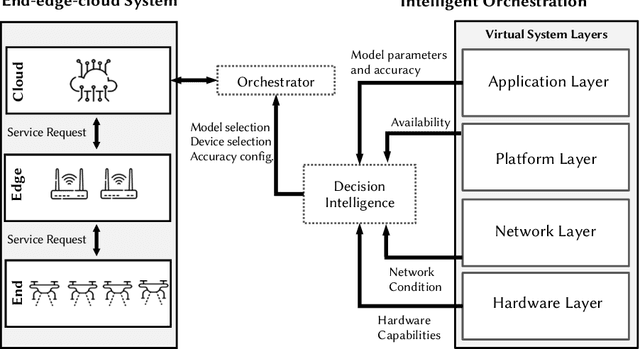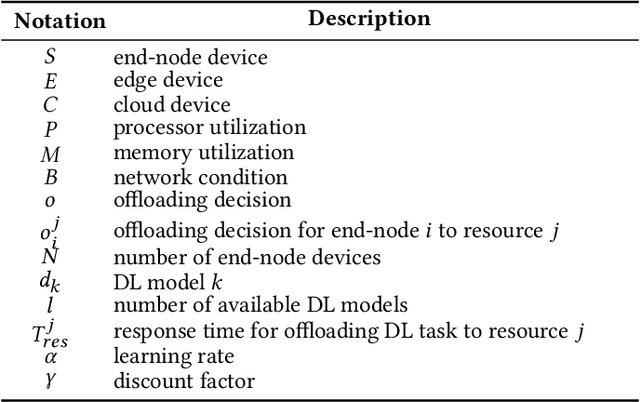Anil Kanduri
HiDP: Hierarchical DNN Partitioning for Distributed Inference on Heterogeneous Edge Platforms
Nov 25, 2024



Abstract:Edge inference techniques partition and distribute Deep Neural Network (DNN) inference tasks among multiple edge nodes for low latency inference, without considering the core-level heterogeneity of edge nodes. Further, default DNN inference frameworks also do not fully utilize the resources of heterogeneous edge nodes, resulting in higher inference latency. In this work, we propose a hierarchical DNN partitioning strategy (HiDP) for distributed inference on heterogeneous edge nodes. Our strategy hierarchically partitions DNN workloads at both global and local levels by considering the core-level heterogeneity of edge nodes. We evaluated our proposed HiDP strategy against relevant distributed inference techniques over widely used DNN models on commercial edge devices. On average our strategy achieved 38% lower latency, 46% lower energy, and 56% higher throughput in comparison with other relevant approaches.
ECG Unveiled: Analysis of Client Re-identification Risks in Real-World ECG Datasets
Aug 02, 2024



Abstract:While ECG data is crucial for diagnosing and monitoring heart conditions, it also contains unique biometric information that poses significant privacy risks. Existing ECG re-identification studies rely on exhaustive analysis of numerous deep learning features, confining to ad-hoc explainability towards clinicians decision making. In this work, we delve into explainability of ECG re-identification risks using transparent machine learning models. We use SHapley Additive exPlanations (SHAP) analysis to identify and explain the key features contributing to re-identification risks. We conduct an empirical analysis of identity re-identification risks using ECG data from five diverse real-world datasets, encompassing 223 participants. By employing transparent machine learning models, we reveal the diversity among different ECG features in contributing towards re-identification of individuals with an accuracy of 0.76 for gender, 0.67 for age group, and 0.82 for participant ID re-identification. Our approach provides valuable insights for clinical experts and guides the development of effective privacy-preserving mechanisms. Further, our findings emphasize the necessity for robust privacy measures in real-world health applications and offer detailed, actionable insights for enhancing data anonymization techniques.
Characterizing Accuracy Trade-offs of EEG Applications on Embedded HMPs
Feb 15, 2024Abstract:Electroencephalography (EEG) recordings are analyzed using battery-powered wearable devices to monitor brain activities and neurological disorders. These applications require long and continuous processing to generate feasible results. However, wearable devices are constrained with limited energy and computation resources, owing to their small sizes for practical use cases. Embedded heterogeneous multi-core platforms (HMPs) can provide better performance within limited energy budgets for EEG applications. Error resilience of the EEG application pipeline can be exploited further to maximize the performance and energy gains with HMPs. However, disciplined tuning of approximation on embedded HMPs requires a thorough exploration of the accuracy-performance-power trade-off space. In this work, we characterize the error resilience of three EEG applications, including Epileptic Seizure Detection, Sleep Stage Classification, and Stress Detection on the real-world embedded HMP test-bed of the Odroid XU3 platform. We present a combinatorial evaluation of power-performance-accuracy trade-offs of EEG applications at different approximation, power, and performance levels to provide insights into the disciplined tuning of approximation in EEG applications on embedded platforms.
Adaptive Workload Distribution for Accuracy-aware DNN Inference on Collaborative Edge Platforms
Oct 16, 2023Abstract:DNN inference can be accelerated by distributing the workload among a cluster of collaborative edge nodes. Heterogeneity among edge devices and accuracy-performance trade-offs of DNN models present a complex exploration space while catering to the inference performance requirements. In this work, we propose adaptive workload distribution for DNN inference, jointly considering node-level heterogeneity of edge devices, and application-specific accuracy and performance requirements. Our proposed approach combinatorially optimizes heterogeneity-aware workload partitioning and dynamic accuracy configuration of DNN models to ensure performance and accuracy guarantees. We tested our approach on an edge cluster of Odroid XU4, Raspberry Pi4, and Jetson Nano boards and achieved an average gain of 41.52% in performance and 5.2% in output accuracy as compared to state-of-the-art workload distribution strategies.
Edge-centric Optimization of Multi-modal ML-driven eHealth Applications
Aug 04, 2022



Abstract:Smart eHealth applications deliver personalized and preventive digital healthcare services to clients through remote sensing, continuous monitoring, and data analytics. Smart eHealth applications sense input data from multiple modalities, transmit the data to edge and/or cloud nodes, and process the data with compute intensive machine learning (ML) algorithms. Run-time variations with continuous stream of noisy input data, unreliable network connection, computational requirements of ML algorithms, and choice of compute placement among sensor-edge-cloud layers affect the efficiency of ML-driven eHealth applications. In this chapter, we present edge-centric techniques for optimized compute placement, exploration of accuracy-performance trade-offs, and cross-layered sense-compute co-optimization for ML-driven eHealth applications. We demonstrate the practical use cases of smart eHealth applications in everyday settings, through a sensor-edge-cloud framework for an objective pain assessment case study.
Hybrid Learning for Orchestrating Deep Learning Inference in Multi-user Edge-cloud Networks
Feb 21, 2022



Abstract:Deep-learning-based intelligent services have become prevalent in cyber-physical applications including smart cities and health-care. Collaborative end-edge-cloud computing for deep learning provides a range of performance and efficiency that can address application requirements through computation offloading. The decision to offload computation is a communication-computation co-optimization problem that varies with both system parameters (e.g., network condition) and workload characteristics (e.g., inputs). Identifying optimal orchestration considering the cross-layer opportunities and requirements in the face of varying system dynamics is a challenging multi-dimensional problem. While Reinforcement Learning (RL) approaches have been proposed earlier, they suffer from a large number of trial-and-errors during the learning process resulting in excessive time and resource consumption. We present a Hybrid Learning orchestration framework that reduces the number of interactions with the system environment by combining model-based and model-free reinforcement learning. Our Deep Learning inference orchestration strategy employs reinforcement learning to find the optimal orchestration policy. Furthermore, we deploy Hybrid Learning (HL) to accelerate the RL learning process and reduce the number of direct samplings. We demonstrate efficacy of our HL strategy through experimental comparison with state-of-the-art RL-based inference orchestration, demonstrating that our HL strategy accelerates the learning process by up to 166.6x.
Online Learning for Orchestration of Inference in Multi-User End-Edge-Cloud Networks
Feb 21, 2022



Abstract:Deep-learning-based intelligent services have become prevalent in cyber-physical applications including smart cities and health-care. Deploying deep-learning-based intelligence near the end-user enhances privacy protection, responsiveness, and reliability. Resource-constrained end-devices must be carefully managed in order to meet the latency and energy requirements of computationally-intensive deep learning services. Collaborative end-edge-cloud computing for deep learning provides a range of performance and efficiency that can address application requirements through computation offloading. The decision to offload computation is a communication-computation co-optimization problem that varies with both system parameters (e.g., network condition) and workload characteristics (e.g., inputs). On the other hand, deep learning model optimization provides another source of tradeoff between latency and model accuracy. An end-to-end decision-making solution that considers such computation-communication problem is required to synergistically find the optimal offloading policy and model for deep learning services. To this end, we propose a reinforcement-learning-based computation offloading solution that learns optimal offloading policy considering deep learning model selection techniques to minimize response time while providing sufficient accuracy. We demonstrate the effectiveness of our solution for edge devices in an end-edge-cloud system and evaluate with a real-setup implementation using multiple AWS and ARM core configurations. Our solution provides 35% speedup in the average response time compared to the state-of-the-art with less than 0.9% accuracy reduction, demonstrating the promise of our online learning framework for orchestrating DL inference in end-edge-cloud systems.
AMSER: Adaptive Multi-modal Sensing for Energy Efficient and Resilient eHealth Systems
Dec 13, 2021



Abstract:eHealth systems deliver critical digital healthcare and wellness services for users by continuously monitoring physiological and contextual data. eHealth applications use multi-modal machine learning kernels to analyze data from different sensor modalities and automate decision-making. Noisy inputs and motion artifacts during sensory data acquisition affect the i) prediction accuracy and resilience of eHealth services and ii) energy efficiency in processing garbage data. Monitoring raw sensory inputs to identify and drop data and features from noisy modalities can improve prediction accuracy and energy efficiency. We propose a closed-loop monitoring and control framework for multi-modal eHealth applications, AMSER, that can mitigate garbage-in garbage-out by i) monitoring input modalities, ii) analyzing raw input to selectively drop noisy data and features, and iii) choosing appropriate machine learning models that fit the configured data and feature vector - to improve prediction accuracy and energy efficiency. We evaluate our AMSER approach using multi-modal eHealth applications of pain assessment and stress monitoring over different levels and types of noisy components incurred via different sensor modalities. Our approach achieves up to 22\% improvement in prediction accuracy and 5.6$\times$ energy consumption reduction in the sensing phase against the state-of-the-art multi-modal monitoring application.
 Add to Chrome
Add to Chrome Add to Firefox
Add to Firefox Add to Edge
Add to Edge